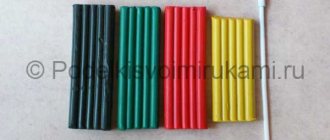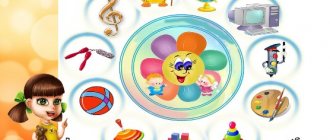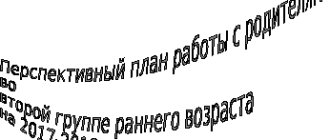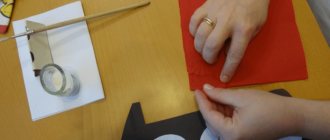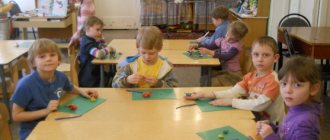Theoretical aspects of modeling in the middle group
The child’s desire to do something with his hands must be welcomed. Activities with bulk materials, mosaics, construction sets and small figures stimulate the nerve receptors on the fingertips. The active development of hand sensory has a positive effect on the level of thinking and speech abilities.
Activities with loose and plastic elements develop fine motor skills and sensory perception
Working with plastic materials - modeling - is included in a set of classes for the development of fine motor skills. Creating simple shapes from sand (including kinetic sand), clay and plasticine exercises the brush in dexterity and flexibility. Kneading these materials with your hands, the child relaxes - modeling has a therapeutic effect.
Interaction with plastic materials relaxes the arm muscles and evokes positive emotions in the child.
With plasticine and other materials for modeling, pupils of the middle group play and practice in various routine moments:
- in art classes once every two weeks: creating crafts from plasticine;
- during educational and research activities: familiarization with the properties of clay, sand, dough;
- as an independent activity in the break room;
- in individual sessions with a psychologist as art therapy;
- on a walk: modeling from sand or snow in a playful way.
Secondary preschoolers sculpt not only crafts, but also in the psychologist’s office - during plasticine therapy classes
Fine arts classes are devoted to modeling as a form of productive creativity. Children 4–5 years old work with plasticine, less often with plastic or salty dough. The goal of modeling classes in the middle group is to develop the ability to sculpt objects of various shapes and sizes, including composite ones. The teacher plans tasks for classes taking into account the age and individual characteristics of the children.
Table: tasks for modeling classes in the middle group
| Educational |
|
| Developmental |
|
| Educational |
|
Modeling classes expand and consolidate children’s knowledge, for example, about vegetables
Practical modeling work in the middle group lasts 10–12 minutes. If the task is given in a playful way during a walk or the child independently works with plasticine in a creative corner, the duration of the process increases.
Teaching sculpting techniques is carried out through sequential demonstration of actions by the teacher. Each stage of work is preceded by an oral comment.
Important to remember. In children 4–5 years old, attention and memory are involuntary. The teacher’s explanation should be concise, clear and at the same time interesting for the children.
In the middle group, children are expected to fashion the parts after the teacher. Activities alternate: auditory and visual perception with practical work. When the children are modeling, the teacher observes, praises, and encourages. Help for those lagging behind is possible:
- hint on how to do it, how to fix it,
- individual showing,
- joint execution: the teacher directs the movement of the child’s fingers and hands.
Mastering sculpting techniques in the middle group is carried out through explanation and demonstration
Combination with other types of visual activities
- Applique is the addition of the base of a craft or a collective composition with small elements connected to each other. Paper applique.
Collective work in the middle group turns out bright if you combine various techniques and techniques of art activities
- Application with natural materials: seeds, cereals, coffee beans.
The use of natural materials allows you to create original crafts
- Gouache is painted on dry figures made from salt dough.
It is recommended to paint the fashioned salt dough treats with gouache
Long-term plan for modeling in the middle group
Anastasia Mirsaidova
Long-term plan for modeling in the middle group
PERSPECTIVE PLAN FOR MODELING MIDDLE GROUP
T. S. Komarova “Classes in visual arts in the middle group”
I. A. Lykova “Art activities in kindergarten. Middle group"
G. S. Shvaiko “Fine art classes in kindergarten. Middle group"
D. N. Koldina “ Modeling with children 4-5 years old”
SEPTEMBER
1 object “Eared pyramids” Learn to sculpt pyramids from disks of different sizes with the top of an animal. Show planning of Lykov’s work “Art activities in kindergarten. Middle group” , p. 28
2 Modeling from plasticine “Basket with berries” Learn to sculpt a hollow object with a handle. Continue to teach how to roll small balls between Koldin’s palms, “ Modeling with children 4-5 years old ,” p. 13
3 Modeling “Cucumber beets” Introduce the techniques of sculpting oval shapes . Learn to convey the features of each subject Komarov “Classes in visual activities in the middle group” , p. thirty
4 Modeling from plasticine “Pie” Continue to sculpt round objects, flattening the ball between the palms, decorate Koldin’s products, p. 19
OCTOBER
1 Modeling “Big and small carrots” Learn to sculpt elongated objects. fasten sculpt large and small objects Komarov, p. 28
2 Modeling “Mushrooms” Strengthen the ability to sculpt familiar objects, using familiar techniques to clarify the shape of Komarov, p. 36
3 Modeling “Plums and Lemons” Strengthen the ability to sculpt oval-shaped objects Komarov, p. 43
4 Plasticineography “Leaves are flying in the wind” Reinforce the ability to apply plasticine in a thin layer on cardboard
NOVEMBER
1 Modeling from plasticine “Snail” Continue rolling out a column from the ball and rolling it into a spiral, pulling and rounding the ends Koldin, p. 42
2 Modeling – plot “Here is a hedgehog - neither head nor legs...” Learn to sculpt a hedgehog, conveying the characteristic features of its appearance, experiment with art materials when creating a prickly “fur coat” Lykov, p. 52
3 Modeling of the Dymkovo toy “Duck” Introduce the toys, draw attention to the streamlined shape, painting by Komarov, p. 47
4 Modeling based on the Hungarian fairy tale “Two Greedy Little Bears” Learn to sculpt bear cubs in a constructive way (in pairs)
Lykova, s. 84
DECEMBER
1 By design To consolidate previously learned techniques in sculpting familiar objects
2 Modeling “Fish” Reinforce the techniques of pulling and flattening while conveying the characteristic features of a fish, learn to designate Komarov’s scales with a stack, p. 40
3 Modeling “Girl in a Fur Coat” Learn to highlight parts of the human figure in clothes, convey them in compliance with the proportions of Komarov, p. 51
4 Modeling from plasticine “Green Christmas tree” Learn to convey the structure of a Christmas tree by connecting columns of different lengths in a certain sequence Koldina, p. 25
JANUARY
1 Vacation
2 Modeling the plot “The Snow Maiden is dancing” Learn to sculpt the Snow Maiden in a long fur coat in a rational way - from a cone, position it vertically, giving stability. Show techniques for conveying movement by Lykov, p. 68
3 Modeling “Cup and Saucer” Continue sculpting the ball by pressing your thumb into it, aligning the edges with your fingers. Roll out the column and attach. Strengthen the ability to roll a ball and flatten it Koldin, p. 18
4 Modeling from plasticine “Pyramid” Strengthen the ability to roll balls of different sizes and flatten them between the palms, arrange the resulting circles in a certain order Koldina, p. 41
FEBRUARY
1 Introduction to small-form sculpture Introduce a new type of fine art - small-form sculpture. Learn to understand the content of sculpture and its means . Give an idea that sculpture is made from various materials Shvaiko “Fine art classes in kindergarten. Middle group” , p. 76
2 Modeling from plasticine “Airplanes” Continue rolling out the columns on the cardboard with forward and backward movements and connecting them. Practice working with the Koldin stack, p. 32
3 Modeling (collective)
“Birds at the feeder” Learn to convey a simple pose. Learn to combine your work with your friends. Komarova, s. 65
4 Modeling with additional with the material “Boat” Continue to teach how to roll out an oval from a ball, flatten it and press the middle with your fingers, tighten and trim the edges. Learn to complement the image with details Koldin, p. 22
MARCH
1 Modeling from plasticine “Family of nesting dolls” Learn to sculpt an oval-shaped object using a plastic method, pressing the craft from below for stability. Continue to introduce the smoothing technique. Strengthen the ability to decorate a product with bas-relief Koldin, p. 33
2 Modeling (collective)
“Duck with ducklings” Continue to introduce Dymkovo toys. Learn to sculpt figures on a stand, conveying the difference in size Komarov, p. 52
3 Plasticineography “Flower - seven-flowered” Reinforce the ability to apply plasticine in a thin layer on cardboard Koldin, p. 35
4 Modeling “Little Goat” Learn to sculpt a four-legged animal. Reinforce Komarov's sculpting , p. 73
APRIL
1 Round Dance” Learn to depict a human figure, correctly representing the advanced ratio of parts with the size of Komarov, p. 63
2 Modeling “A bird pecks grains on a saucer” Strengthen the ability to sculpt familiar objects, using Komarov’s previously learned techniques, p. 82
3 Modeling “Bowl” Learn to sculpt with familiar techniques and new ones - pressing and pulling, leveling them with Komarov’s fingers, p. 70
4 Modeling “Lamb” Introduce Filimonov toys. Create a desire to make a Komarov toy, p. 78
MAY
1 Plasticineography “Spring Rain” Reinforce the ability to apply plasticine in a thin layer on cardboard, complementing the drawing
2 Plasticine molding “Teremok” Learn to divide the columns and lay out the desired image on them in the form of a bas-relief. Strengthen the ability to work with the Koldin stack, p. thirty
3 Modeling from plasticine using natural material “Swan on the Lake” Strengthen the ability to combine natural material and plasticine in a craft. Practice connecting parts Koldina, p. 43
4 Plasticineography “Bouquet of Flowers” Reinforce the ability to apply plasticine in a thin layer on cardboard
Planning classes on modeling in the middle group
By the age of 4–5 years, play becomes the leading activity for children. It is recommended to build creative activities based on a fairy tale plot or in the form of interesting tasks. Children are primed for the end result not in the form of a plasticine craft, but as a successful solution to a problem or a return from a fantastic journey.
Important. The structure of the lesson necessarily includes an introductory part to motivate children to sculpt.
A fantastic character, for example, a sorceress, can interest children in the topic of the lesson.
The modeling lesson in the middle group has a clear structure:
- Organizing time.
- Introductory part.
- Practical work.
- Display of works, summing up.
Between the stages of the lesson, short outdoor games and physical education are held. Changing educational activities to physical activity prevents emotional and physical stress in children.
Important. It is recommended to carry out finger exercises immediately before children begin sculpting. The muscles of the fingers and hands are warmed up, which means they are ready to work.
Finger games and exercises warm up your hands before sculpting
Lesson notes on modeling in the middle group
- Malikova Yu. V. “Modeling class in the middle group. Houses of our city"
- Nikiforova V.I. “Summary of a modeling lesson in the middle group. Mushrooms"
- Kukovyakina M. A. “Modeling class in the middle group. Animal of hot countries"
- Zolotareva V. “Lesson summary on plasticineography. Seven-flowered flower"
- Neiman I. E. “Lessons for a lesson on modeling salt dough. Mukosolka"
The selection includes the most interesting developments of classic modeling topics in the middle group. The “Houses of Our City” lesson can be called integrated, since it is carried out within the framework of moral and patriotic education. The teacher's methodological discovery is the distribution of objects for modeling using a game with cards. The “Mushrooms” lesson is notable for the use of natural and waste materials, as well as original poems from the teacher. Modeling “Animals of Hot Countries” is combined with the appliqué technique, and at the beginning of the notes the teacher describes the purpose of the crafts. That is, children have a real purpose why they sculpt lion cubs. The “Seven-flowered Flower” craft is made using an unconventional technique - plasticineography. The teacher compiled a summary of the introductory lesson. Pros - due to the fairy tale plot, the inclusion of finger exercises and the use of background music during sculpting. The summary of the lesson “Flour Salt” was developed for a circle where children sculpt from salted dough. Development elements can be used in a GCD lesson. Giving children the opportunity to knead their own dough is a way to satisfy their interest in exploration.
Video: modeling lesson in the middle group “Hedgehog”
Open lesson on modeling in the middle group according to the Federal State Educational Standard
Conducting open classes is part of the teacher’s job. This is not a testing event for children; their level of preparation and knowledge will not be assessed. The teacher strives to show the effectiveness of his work. Pedagogical findings and the author’s methods of presenting material are also shared in an open form.
Children should be calm, explain that strangers are just spectators
The lesson can be attended by methodologists, preschool employees, teachers from other kindergartens, students and young professionals.
Methodologists are present at the lesson as inspectors. The following aspects are assessed:
- Availability of detailed lesson notes.
- The topic of the lesson, its relevance for the middle group.
- A variety of pedagogical techniques and their correspondence to the characteristics of the group.
- Implementation of an individual-personal approach to learning.
- Maintaining a positive emotional background.
- Using computer technology in the classroom.
- Achieving set goals and objectives.
Methodologists evaluate the lesson and its documentation (notes, preliminary work plan, appendices)
Preparing for an open lesson is no different from preparing for any planned lesson. The teacher works with children, never for the sake of observers.
Important. After the lesson, the teacher conducts a self-analysis of the work done. If something failed, the audience should be informed about this and options for correction in the lesson should be outlined.
Have a recording device (camera or tablet) ready to video record the session. This material can be posted on pedagogical portals.
Video: open modeling lesson (with parents)
Video: sculpting lesson “Mushrooms”
Methodological literature on modeling for the middle group
- Ionova O. S. Secrets of the artist. Games and activities in drawing, modeling, appliqué for preschool children.
- Komarova T. S. Visual activities in kindergarten. Middle group. Federal State Educational Standard.
- Lykova I. A. Visual activities in kindergarten. Middle group. Educational and methodological manual.
- Pavlova O. V. Visual activity and artistic work. Middle group: comprehensive classes. Federal State Educational Standard.
- Tkachenko T. B. Lessons in modeling from plasticine. Practical guide.
If you are teaching children 4–5 years old, get ready: an actively growing vocabulary and ever-expanding ideas about the world around them stimulate the children’s imagination. How many interesting and beautiful things they will have to do during modeling classes!
Middle group. Junior preschool age. Children 4 - 5 years old
Lesson notes. Modeling “Hawthorn Branch” middle group
Lesson summary . Modeling “Hawthorn Berries” middle group Reinforce the ability to roll out small balls using circular movements of your fingers to create hawthorn berries. Arouse in children the desire to create a collective composition. Diversify the ways of dividing plasticine into parts...
Video, modeling master class with children of primary preschool age “Balloons”
MBDOU OV No. 35
“Rucheyok”
Tuapse, Krasnodar Territory Educator Anufaryan K.S.
Abstract Modeling with children of the junior group “Balloons”
Goal: -Mastering a new technique
of pressure sculpting ; -Awakening interest in modeling . Objectives: Generating interest in working with plasticine; Education…
